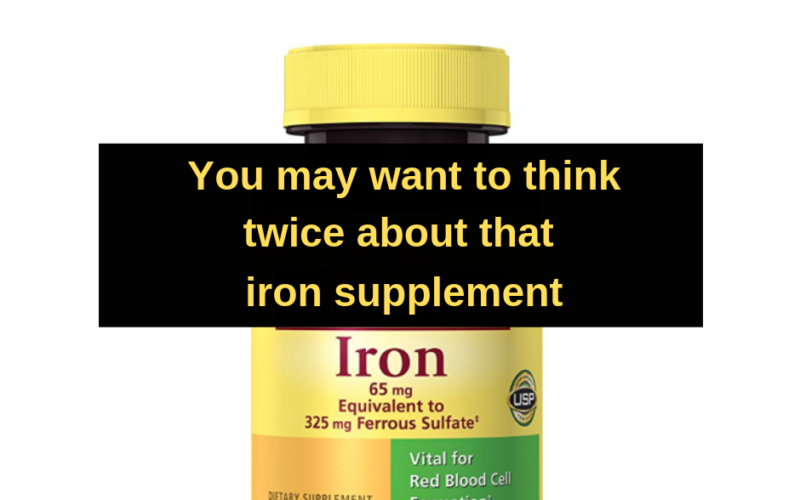 by Rita Wilhelm
by Rita Wilhelm
Many people supplement with iron because they believe they have an iron deficiency. It is of course hard to deny seeing low iron levels in a blood test. But does that really mean the body is low on iron?
Well … maybe. But just because serum (blood) iron levels are low, doesn’t mean whole body iron levels are low.
One can have high iron levels, and still be anemic
Serum (Blood) Iron vs. Stored Iron
Excess iron can be stored away in body organs, such as the liver, heart, spleen, brain, muscle, in joints, blood vessels, and in belly fat. (R)
Stored iron is not necessarily going to show up on an iron blood test. And supplementing with iron may make an iron deficiency worse.
Let me explain. But first … my disclaimer:
| Disclaimer: I am not a doctor. I’m a nutritionist and a researcher. I’m sharing my research and some of my takeaways with you. This article is not intended to tell anyone what to do. It could be that iron is exactly what you need for your iron deficiency. I’m just presenting a different perspective on the cause of low serum (blood) iron. Whatever you do for your health should be between you and your doctor. |
How Much Iron Does the Body Need?
The body absorbs only small amounts of iron, because it doesn’t lose a lot of iron. Most iron is recycled.
Very small amounts of iron are lost during a day. This happens through sweating, shedding skin, menstruation, and from the mucosal lining of the GI tract. This amounts to about 1-2 mg per day.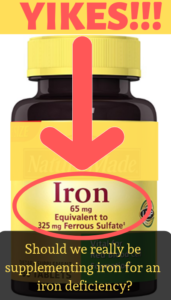 And normally speaking, the body would absorb about 1-2 mg from food per day to make up for this loss. So a vitamin supplement with 65 mg of iron would be overkill … wouldn’t you think?
And normally speaking, the body would absorb about 1-2 mg from food per day to make up for this loss. So a vitamin supplement with 65 mg of iron would be overkill … wouldn’t you think?
Not only is it overkill, it can be dangerous.
Why?
There is no known natural pathway for the body to get rid of excess absorbed iron.
Let me repeat that. And I’ll do it in red this time:
There is no known natural pathway for the body to get rid of excess absorbed iron.
Anemia of Inflammation
The National Institute of Diabetes and Digestive and Kidney Diseases states that:
In anemia of inflammation, you may have a normal or sometimes increased amount of iron stored in your body tissues, but a low level of iron in your blood. Inflammation may prevent your body from using stored iron to make enough healthy red blood cells, leading to anemia.
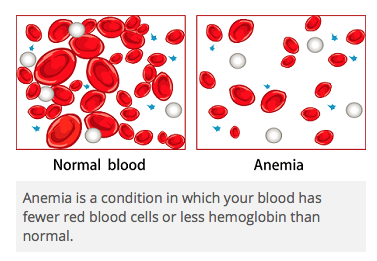
Anemia of inflammation is also called anemia of chronic disease, because this type of anemia commonly occurs in people who have chronic conditions that may be associated with inflammation.
[…]
While anemia of inflammation can affect people of any age, older adults are more likely to have this type of anemia because they are more likely to have chronic diseases that cause inflammation. In the United States, about 1 million people older than age 65 have anemia of inflammation.
Think about that for a moment …
That means over one million U.S. senior citizens over the age of 65 have high iron body stores, low blood iron and that they are likely to suffer from a chronic disease.
And if that iron situation is affecting that many people over 65, how many people is it affecting who might be 60, 50, 40, 30 or even 20 years of age?
And why do most chronic diseases appear later in life?
I believe it has to do with the lifetime buildup of iron.
Anemia in the Elderly
 Eating a Western diet is more likely to cause high iron stores in the elderly.
Eating a Western diet is more likely to cause high iron stores in the elderly.
A study in the US National Library of Medicine found that iron supplements, high intakes of vitamin C (which increases iron absorption when taken together) and red meat were the main causes of high iron stores. (R)
In the US, it has been estimated that approximately 11% of men and 10% of women aged 65 and above are anaemic, and that these figures double at the age of 85, with prevalence rates reaching 50–60% in residential/nursing homes. Although one of the conclusions from the Framingham Heart Study, initiated in 1948–1950, with a cohort of ∼6000 adults living in Framingham MA, was that free-living elderly white American eating a Western diet are more likely to have high iron stores, not iron deficiency, iron supplement use and high intakes of vitamin C and red meat were shown to be important determinants of iron status.
Myelin is produced by cells called oligodendrocytes.These cells, along with myelin, have the highest levels of iron of any cells in the brain, Bartzokis says, and circumstantial evidence has long supported the possibility that brain iron levels might be a risk factor for age-related diseases like Alzheimer’s. Although iron is essential for cell function, too much of it can promote oxidative damage, to which the brain is especially vulnerable.
Note: All white wheat flour in the United States is fortified (supplemented) with iron … by law.
(Perhaps that’s the problem with the Western diet.)
Iron Buildup (even when anemic)
The build up of iron in the organs and tissues over a lifetime has a significant role in chronic disease and in the aging process.
Iron supplementation, cooking in cast iron, eating a lot of red meat (especially with vitamin C or beta-carotene) and eating fortified foods can lead to increased iron stores in the body.
People with Scottish, Irish or Northern European ancestry, may have a genetic condition called Hereditary Hemochromatosis, in which they absorb much more iron compared to the average person. People with these genes need to be particularly careful about taking iron supplements, as well as eating fortified foods or red meat.
Below are some issues related to the lifetime buildup of iron. And these issues can all show anemia.
Iron and Brain Diseases
Iron levels in the brain increase with age, and is implicated in the development of Alzheimer’s’ Parkinson’s and Huntington’s disease. (R)
Iron and Alzheimer’s Disease
A UCLA study suggests iron is the cause of Alzheimer’s disease.
While most Alzheimer’s researchers focus on the buildup of tau or beta-amyloid that results in the signature plaques associated with the disease, Bartzokis has long argued that the breakdown begins much further “upstream.” The destruction of myelin, the fatty tissue that coats nerve fibers in the brain, he says, disrupts communication between neurons and promotes the buildup of the plaques. These amyloid plaques in turn destroy more and more myelin, disrupting brain signaling and leading to cell death and the classic clinical signs of Alzheimer’s. [..] Although iron is essential for cell function, too much of it can promote oxidative damage, to which the brain is especially vulnerable.
Iron levels in the brain can even predict when a person may get Alzheimer’s. (R)
Iron and Parkinson’s Disease
People with Parkinson’s show altered iron levels in their brains. (R)
It’s long been known that excess iron is found in the brains of patients with Parkinson’s disease (PD), an incurable neurodegenerative condition that affects motor function. The mechanism by which the iron wreaks damage on neurons involved in PD has not been clear. Research from the Andersen lab at the Buck Institute suggests that the damage stems from an impairment in the lysosome, the organelle that acts as a cellular recycling center for damaged proteins. Scientists report the impairment allows excess iron to escape into the neurons where it causes toxic oxidative stress.
ScienceDaily
Iron and Huntington’s Disease
Researchers have found iron accumulation in brain tissue when doing autopsies on Huntington’s patients.
In a mouse model of Huntington’s, researchers were able to improve motor function after doing a chelation treatment to remove excess iron.
Iron accumulation in the mitochondria of brain cells may drive Huntington’s disease progression, researchers report. Removing excess iron with an FDA-approved treatment was seen to rescue mitochondrial function and improved motor endurance in a mouse model of the disease.
Huntington Disease News
Iron and Heart Disease
Iron consumption can increase one’s risk for heart disease.
As the level of iron goes up in your bloodstream, so apparently does your risk for heart attack and stroke. A new study by Japanese researchers shows that high-level iron injections can cause almost immediate constriction of blood vessels. In fact, the scientists believe the iron damage could be the first step in a cascade of events leading to the thickening and hardening of the arteries known as atherosclerosis.
WebMD
Iron and Cancer
A recent study found that two iron compounds, which are used in supplements and food additives, raise levels of a cancer biomarker — even when consumed in low amounts. (R)
Cancer cells need iron to grow and spread. New cancer therapies are looking at interfering with iron as a way to combat cancer:
Cancer cells have a higher demand for iron in order to sustain their proliferative capacity. Considering this as their Achilles’ heel, several approaches seek to interfere with iron handling in cancer cells, either by directly modulating iron-regulated genes or by using iron chelators.
(R)
Iron and Diabetes
Hopefully you’ve already read my article: Is Diabetes an Infection? 🙂
In a nutshell, I basically explain how bad bacteria thrive in a high iron environment, and how when they die, toxins (endotoxins) are released that then make their way into our bloodstream and liver, causing ‘endotoxemia’. Metabolic syndrome, PCOS and type 2 diabetes are all forms of endotoxemia.
Iron and Arthritis
Many people with hereditary hemochromatosis (a genetic condition of increased iron absorption) have arthritis. Yet, many arthritic patients are anemic.
This can be due to a bacterial infection that flourishes in a high iron environment, causing anemia of chronic inflammation. This eventually can lead to septic arthritis.
Iron and Menopause
Iron levels increase in women as a result of decreasing menstrual periods. (R)
… iron supplementation is not recommended for postmenopausal women, because as women age, their need for iron goes down. Some recent research has shown that postmenopausal women may be at risk for anemia. But, even with those findings in mind, taking additional iron may not be a good option for you. Before you take a vitamin supplement that contains iron, talk to your doctor.
The Mayo Clinic (R)
[…]
even with the increased risk of anemia, postmenopausal women still may experience iron overload if they take in too much iron. The signs and symptoms of iron overload usually develop slowly and subtly, making them difficult to recognize. They include nonspecific symptoms such as joint pain, fatigue and abdominal pain.
Bacteria and Iron
Microorganisms play a huge role in our health. We have a symbiotic relationship with certain microbes, but not with others.
Iron wakes up dormant pathogenic (bad) bacteria.When there is plenty of iron, bad bacteria flourish.
As their populations grow, their demand for iron grows. If there is not enough iron, they will compete with the human body for that iron.
Bacteria can activate a virus, attack body tissues, cause autoimmune issues, and create stress in an attempt to get the human body to secrete the stress molecule, norepinephrine. This then creates the gateway for bad bacteria to tap into our iron stores.
Can Iron Deficiency (Anemia) be Caused by Bacteria?
Yes. Low iron is commonly seen in infectious diseases.
To sustain an infection, nearly all bacteria, fungi and protozoa require a continuous supply of iron. (R)
In a protective move, the body moves iron out of the blood stream to deprive microbes of iron. It also absorbs less iron. (R, R, R)
A team of Italian researchers has found that a bacteria, Helicobactor pylori, may play a role in some cases of iron-deficiency anemia. The researchers […] suggest that eradicating H. pylori with antibiotics can lead to recovery from anemia and eliminate the need for iron supplementation.
WebMD
Bacteria and Endotoxins
As I mentioned earlier, those iron-loving microbes release toxins when they die.
If there are lots of these microbes in the gut, there can be a huge load of endotoxins that are released.
When these toxins get into the bloodstream, it signals to the immune system that there is a problem.
In a healthy person, these toxins stay in the digestive tract and eventually get pooped out.
How do Endotoxins Get into the Bloodstream?
There are 2 pathways for endotoxins to get into the bloodstream.
1) Via a leaky gut. (Iron is one of the causes a leaky gut.) (R, R,)
2) Via fat absorption. (These toxins hitch a ride when we absorb fats.) This happens via chylomicrons. (R , R, R, R, R )
Our body responds to these endotoxins that make their way into the blood stream, with an “Acute Phase Reaction”, in an attempt to keep iron away from bacteria.
What is an Acute Phase Reaction?
The acute phase reaction (or response) is a systematic (full-body) response to stress caused by infection or other trauma to body tissues.
When there is a bacterial infection for instance, a certain white blood cell (macrophages) will take iron out of the bloodstream and engulf it for safe keeping and hold it in various organs and tissues, to keep it away from bacteria. (This is a reason why blood iron could be low, while iron storage is high.)
This full body response to an infection changes the concentration of nutrients in the blood to protect itself, and to fight the infection.
This is one of the reasons why so many studies are conflicting. Blood level of certain nutrients and compounds can be up or down depending on if there is an infection or not. Just because iron is low, doesn’t mean we need more iron.
When there is an acute phase reaction to bacteria, the following happens:
1) blood iron levels go down
2) blood zinc levels go down
3) blood copper levels go up (but only if there is enough stored or dietary copper.)
Here’s a chart, listing some of the other micronutrient changes that happen: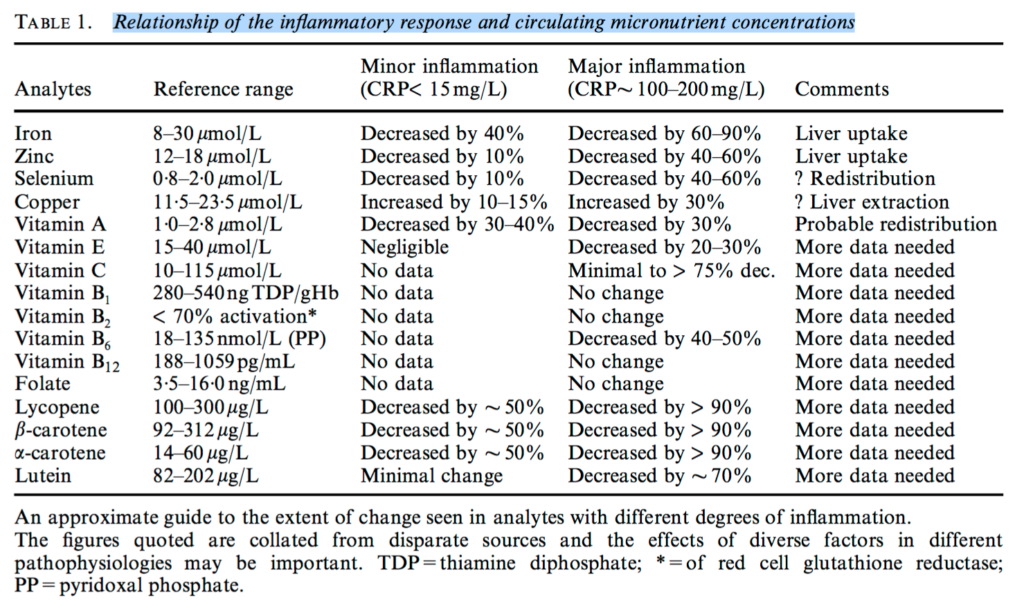
High Copper – Low Iron (Blood)
As we saw above, high serum copper and low serum iron are part of the acute phase reaction.
Many people think that because there is high copper in the blood, that they have copper toxicity. But that may not be the case at all. (Unless of course they have the genetics for Wilson’s disease).
It is important to note that serum copper largely reflects serum ceruloplasmin and is not a sensitive indicator of copper nutritional status. Serum ceruloplasmin levels are known to increase by 50% or more under certain conditions of physical stress, such as trauma, inflammation, or disease. Because over 90% of serum copper is carried in ceruloplasmin, which is increased in many inflammatory conditions, elevated serum copper may simply be a marker of inflammation that accompanies atherosclerosis.
The Linus Pauling Institute at Oregon State University (R)
Copper to the Rescue?
So let’s switch gears for a second and talk about copper.
Not enough copper can cause anemia.
Copper’s essentiality was first discovered in 1928, when it was demonstrated that rats fed a copper-deficient milk diet were unable to produce sufficient red blood cells. The anemia was corrected by the addition of copper-containing ash from vegetable or animal sources.
Wikipedia
Unlike iron, excess copper is easily excreted from the body in sweat, urine and feces.
Copper is absorbed, transported, distributed, stored, and excreted in the body according to complex homeostatic processes which ensure a constant and sufficient supply of the micronutrient while simultaneously avoiding excess levels. If an insufficient amount of copper is ingested for a short period of time, copper stores in the liver will be depleted. Should this depletion continue, a copper health deficiency condition may develop.
Wikipedia
Genetic Conditions of Copper Toxicity
In normal situations, the body should easily be able to get rid of excess copper.
There are a few hereditary conditions however, such as Menke’s disease and Wilson’s disease, where copper does not go to the skin and tissues. In Menke’s disease, infants usually don’t live past the age of three years old.
One of the telltale signs of Wilson’s disease are dark rings around the iris, called Kayser-Fleischer rings. (See below picture.) 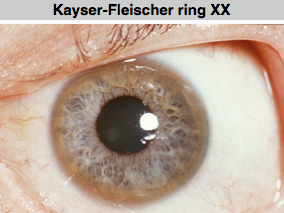
Another diagnostic test for Wilson’s disease is a high amount of copper in the urine. (R)
It Takes Copper to Move Iron
It takes copper to move iron in the body via a copper-carrying protein called ceruloplasmin, and it takes copper to deal with a bacterial infection.
Copper is required to transport iron to and from the tissues.
Adequate copper nutritional status is necessary for normal iron metabolism and red blood cell formation. Anemia is a clinical sign of copper deficiency, and iron has been found to accumulate in the livers of copper-deficient animals, indicating that copper (via the copper-containing ceruloplasmin) is required for iron transport to the bone marrow for red blood cell formation.
Linus Pauling Institute
The connection between copper availability and iron metabolism has also been established in humans; copper deficiency can lead to secondary ceruloplasmin deficiency and hepatic iron overload and/or cirrhosis. Oral copper supplementation restored normal ceruloplasmin levels and plasma ferroxidase activity and corrected the iron-metabolism disorder in a copper-deficient subject. Moreover, infants fed a high iron formula absorbed less copper than infants fed a low iron formula, suggesting that high iron intakes may interfere with copper absorption in infants..
Copper as an Antibiotic
Many ancient cultures, such as the Egyptians, Aztecs, and Greeks, used copper to treat burns and infections. Holding water in a copper container overnight sterilizes water. (Which is a good side tip to know in case clean water is hard to come by.)
Holding water in a copper container overnight sterilizes water. (Which is a good side tip to know in case clean water is hard to come by.)
Studies show that storing drinking water in copper pots kills diarrhea causing bacteria. (R, R )
Bacteria and viruses cannot survive on copper. This is the reason why hospitals are now looking at changing from stainless steel countertops, to copper surfaces. This is to deal with antibiotic resistant bacteria.
Copper can kill or inactivate a variety of pathogens by interacting with oxygen and modifying oxygen molecules. In bacteria, this disrupts the outer layer, damaging the genetic material and cell machinery, which can lead to cell death. A recent study found that copper also destroys norovirus.
The Washington Post:
There has been only one published clinical trial showing how copper reduces infections in hospitals. The results, however, were striking: Researchers said the study, which took place between July 2010 and June 2011, showed that copper surfaces reduced infection rates by 58 percent.
Could it be that the body increases the amount of copper in the blood in an effort to fight infection?
Bacteria need metals like iron, calcium and manganese for every part of their lives. In fact, bacterial cells covet iron so much that many don’t even have a way to get rid of it – only to let it in. They’ll store it for later use if they have to. But copper is one metal that pathogenic bacteria don’t want or need.
The University of Arizona
That’s why when macrophages find unwanted bacteria in the lungs, one of the first things they do is deliver them to a compartment where they’re starved of the metals they need and instead bombarded with copper. The process is called mismetalization, and it’s deadly.
Can Dietary Copper Fix an Iron Deficiency?
That depends what the reason is for the iron deficiency. Low copper intake can cause anemia, because it takes copper to make ceruloplasmin, which is a protein that is involved in moving iron.
One of the most common clinical signs of copper deficiency is an anemia that is unresponsive to iron therapy, but corrected by copper supplementation. (R)
Unfortunately, treating low iron due to a copper deficiency with more iron, can create even more of both an iron and a copper deficiency issue. Studies show that a higher iron intake is associated with increased dietary copper requirements. (R)
Excess alcohol, vitamin C, and zinc (among other things) can cause both anemia and a copper deficiency.
Case Study: Fixing an iron deficiency by treating a copper deficiency with cocoa
There is an interesting case in which excessive alcohol intake caused a 71-year-old man to become so anemic that he was unable to walk. After analysis, it was found that he was anemic due to a copper deficiency. The doctors supplemented him with a cocoa drink (cocoa is high in copper), and he was able to walk again. (R)

Can Dietary Copper Fix an Iron Overload?
High iron increases the need for copper, and can cause a copper deficiency. (R)
Interestingly, fixing a copper deficiency may also help those with too much iron in their blood.
Case Study: Fixing iron overload caused by too much zinc with copper supplementation
Another interesting case involves a 57-year-old man with a very severe case of Anemia of Inflammation. (Low blood iron with high total body iron.) His hemoglobin level was very low at 3 g/dL. (A normal range is 12-16 g/dL). Yet, his ferritin level was very high, at over 2687 μg/L. (A normal range is 55-345 μg/L).
The doctors found out that he was very copper deficient due to the high amount of zinc in his denture cream.
The doctors supplemented him with copper, which in turn normalized his iron levels, and improved his symptoms.
The authors of the case study concluded that:
Iron overload due to copper deficiency–related aceruloplasminemia [a disorder in which iron gradually accumulates in the brain and other organs] represents a novel, easily treatable form of secondary iron excess, and provides further illustration of the close connection between iron and copper metabolism.
Blood Journal
As you read from the case study above, a copper deficiency and an iron overload was caused by too much zinc in the gentleman’s denture cream.
Zinc supplementation can do this too. Doctors may incorrectly diagnose a zinc deficiency, and treat it with zinc. ( Remember … zinc is part of the acute phase reaction, so blood levels go down.)
This zinc supplementation in turn can lead to a copper deficiency.
Doctors often incorrectly diagnose zinc deficiency, according to a clinical audit in Scotland, and so induce cases of copper deficiency because misplaced treatment results in too much zinc.
Medical News Today
Published in the Journal of Clinical Pathology, a publication from The BMJ, the findings come from an analysis of case notes from 70 patients prescribed zinc supplements at Glasgow hospitals in the decade from 2000-10.
The study found that 62% of patients were prescribed zinc at doses sufficient to cause copper deficiency.
Researchers also found:
Clinical copper deficiency is most often due to zinc ingestion, which blocks copper absorption (see section on zinc treatment of Wilson disease). To produce copper deficiency, zinc ingestion has to occur over a period of time, probably a minimum of 2 months. Therefore, ingestion of zinc (e.g., to treat of colds with zinc lozenges) is not a risk if ingested for a few days only per episode. In addition, zinc taken with food tends to get bound to substances in food and has much less effect on copper absorption. Occasionally, zinc ingestion results from intentional swallowing of foreign objects that contain zinc and that remain in the stomach for long periods. More rarely, copper deficiency can result from surgical removal of a large section of the small intestine, thus greatly reducing absorption of copper.
R
High Iron with High Vitamin C Intake Impacts Copper and Makes Rats Anemic
Vitamin C is necessary for survival. We need it. There may however, be better ways of including vitamin C in the diet, as vitamin C does impact other nutrients in a meal.
Vitamin C increases iron absorption. And, vitamin C significantly decreases copper absorption.
In this study, rats were given either a copper deficient or copper adequate diet.
Their diet also had either a moderate, or a high level of iron.
And their diet included vitamin C levels that were either low, or high.
It was found that the high iron diet with high ascorbic acid intake, caused tissue copper to be used up. Rats that didn’t have enough copper suffered severe anemia.
Adverse effects of high dietary iron and ascorbic acid on copper status in copper-deficient and copper-adequate rats.
R
The effects of elevated dietary ascorbic acid and iron on copper utilization were examined. Male Sprague-Dawley rats were fed one of two levels of Cu (deficient, 0.42 microgram Cu/g, or adequate, 5.74 micrograms Cu/g), Fe (moderate, 38 micrograms Fe/g or high, 191 micrograms Fe/g), and ascorbic acid (low, 0% or high, 1% of the diet) for 20 d. High Fe decreased (p less than 0.05) Cu absorption only in Cu-deficient rats. High ascorbic acid significantly decreased tissue Cu levels in Cu-adequate rats. High Fe with ascorbic acid caused severe anemia in Cu-deficient rats and decreased plasma ceruloplasmin by 44% in Cu-adequate rats. Cu,Zn-superoxide dismutase activity in erythrocytes was decreased (p less than 0.05) by 14% during Cu deficiency but was not affected by Fe or ascorbic acid. These results may be important to individuals with high intakes of Fe and ascorbic acid.
Symptoms of a Copper Deficiency
Symptoms of a copper deficiency include fatigue, joint pain, peripheral neuropathy, brittle bones, grey hair, difficulty walking, vision loss, sensitivity to cold, mood swings and can be a leading cause of heart disease. (R, R, R, R )
A copper deficiency may be a leading cause of ischaemic heart disease. (R)
Sort of sounds like the aging process, doesn’t it?
What Foods are High in Copper?
 Dark chocolate and potatoes are my favorites. Most of the copper in potatoes is in the flesh, while most of the iron is in the peel.
Dark chocolate and potatoes are my favorites. Most of the copper in potatoes is in the flesh, while most of the iron is in the peel.
Other food sources are soy, flax seed, pumpkin seeds, mushrooms, nuts, shrimp, oysters and liver.
Other Sources of Copper
Drinking water that has been sitting in copper pipes can be a source of copper, depending how long the water has sat in the pipes.
Drinking water from a copper cup or water bottle is an option. ( Read: Are Copper Water Bottles Safe?)
Many people who have arthritis, find great relief from wearing copper jewelry.
Trace amounts of copper are absorbed through the skin, and in one study of 240 people with rheumatoid arthritis, those wearing copper bracelets had a statistically significant improvement compared with those wearing a placebo. Each copper bracelet lost an average 13mg of copper during the trial.
The Telegraph UK
Another theory is that copper bracelets work through a process known as iontophoresis, in which copper leaches excess sulphates from the body, where they are deposited as a blue-green discolouration on the skin. The efficacy of the bracelets is thought to depend on the level of copper in your body. If deficient, you may benefit. Bracelets combining copper with magnets are worth trying for pain relief.
Fabrics are now made with copper fused into yarn. The U.S. Marines wear copper infused socks to help with athlete’s foot. (R)
Copper socks were used for the 33 Chilean miner’s when they were trapped in a mine for 69 days.
The 33 Chilean miners who were trapped underground after their mine collapsed in August 2010 spurred an impromptu experiment, of sorts, into treatments for fungal foot infections.
Live Science
Socks containing copper particles treated the fungal infections the workers suffered better than anti-fungal creams, suggests a report published today in the journal Archives of Dermatology.
Within two weeks of living in the hot and humid conditions, many of the miners began to experience skin problems in their feet. The socks, made by Cupron, Inc., were donated to the miners after antifungal cream failed to relieve their skin problems. Many of the miners reported their skin problems completely resolved within a week of trying on the socks, according to the report.
The sock fibers were “impregnated” with copper oxide, a known anti-bacterial and anti-fungal agent.
In another study, 56 people suffering from an athlete’s foot infection wore copper socks at least 8 hours a day. Within 8-12 days, there was a significant improvement in symptoms and appearance. (R)

Bottom Line
Low blood iron can still mean that whole body iron is high. Iron is implicated in most chronic diseases.
Stored iron and aging go hand in hand, as there is no known excretion pathway for excess iron.
Food already has plenty of iron in it. The body should be able to absorb what it needs to from what we eat.
Considering that the Western diet includes many foods that have added iron, such as breakfast cereals, white flour, and various processed grains, there may already be an overburden of iron on the body.
This overburden can make red meat intake problematic as well.
High stored iron can cause a copper deficiency. And, adding more iron can cause more of a copper deficiency.
Copper is necessary to make the protein ceruloplasmin, which is needed to move iron. Copper is also an antibiotic, and is useful in dealing with the microbes that also want to get their hands on that iron.
So please think twice about iron supplementation, and perhaps give copper a look.

